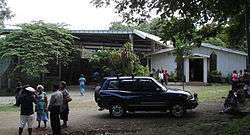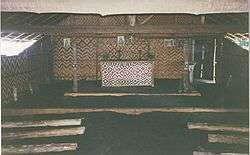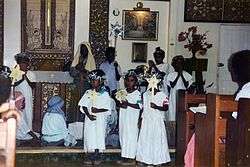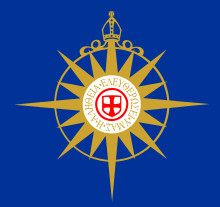Anglican Church of Papua New Guinea
| Anglican Church of Papua New Guinea | |
|---|---|
 [1] [1] | |
| Primate | Clyde Igara |
| Headquarters | Lae, Morobe Province |
| Territory | Papua New Guinea |
| Members | c. 167,000 |
| Website | acpng.org.pg |
The Anglican Church of Papua New Guinea is a province of the Anglican Communion. It was created in 1976 when the Province of Papua New Guinea became independent from the Province of Queensland in the Church of England in Australia (officially renamed the Anglican Church of Australia in 1981[2]) following Papua New Guinea's independence in 1975.
The first Archbishop and Primate of Papua New Guinea was David Hand, the Bishop of Port Moresby. Joseph Kopapa was Primate from 2010 to 2012. Before his election to the primacy, Kopapa was Bishop of Popondota. Prior to the primatial election, it was decided that the primate would have no diocesan responsibilities and would solely take on a national role. His successor as Bishop of Popondota was Lindsley Ihove. Kopapa was succeeded by Clyde Igara, elected on 14 June 2013.
History
Founding of the Anglican mission
Britain assumed sovereignty over southeast New Guinea in 1888 and the General Synod of the Church of England in Australia (now the Anglican Church of Australia) then resolved that "...the recent annexation of portion of New Guinea imposes direct obligation upon the Church to provide for the spiritual welfare both of the natives and the settlers."[3] In 1889 A.A. Maclaren was appointed the first Anglican missionary to the region and in 1890 visited with Copland King.[4] They purchased land at Samarai for a mission station but Maclaren died at the end of 1891 and King withdrew to Australia;[5] in 1892 King returned to Dogura and built a mission house and two South Sea Islands teachers joined him in 1893 and were placed at Taupota and Awaiama; in 1894 a teacher was placed at Boiani.[6] Montagu John Stone-Wigg was appointed Bishop of New Guinea and spent 10 years there, establishing stations at Wanigela[7] and Mukawa on Collingwood Bay in 1898 and Mamba at the mouth of the Mambare River in 1899: by 1901 there were eleven stations along the coast of north Papua (in what are now Northern (Oro) and Milne Bay Provinces) and Anglican influence had extended along 480 km of coast.[6] The Cathedral of SS Peter and Paul[8] in Dogura, Milne Bay Province, is the largest Anglican church in Papua New Guinea. It seats 800, was consecrated in 1939 three years before the outbreak of war in the South Pacific and survived the traumatic Japanese occupation of Papua New Guinea during World War II.[9]
Second World War and recovery

The Japanese had put ashore troops in Papua near Gona by July 1942 with a view to taking Lae and Salamaua.[10] The Japanese did not harass or occupy Dogura mission itself and services continued in the cathedral throughout the war, with congregations amply enlarged by visitors from the Australian and American armed forces.[11] However, the Anglican Church elsewhere fared less well. In Anglican terminology the New Guinea Martyrs were eight Anglican clergy, teachers and medical missionaries killed by the Japanese in 1942,[12] the Anglican Bishop of New Guinea (then a diocese of the ecclesiastical Province of Queensland) Philip Strong having instructed Anglican missionaries to remain at their posts despite the Japanese invasion. Three hundred thirty-three church workers of various denominations were killed during the Japanese occupation of New Guinea.

A statue of Lucian Tapiedi, the one indigenous Papuan[13] among the Anglican martyrs of New Guinea, is installed among the niches with other 20th-century Christian martyrs from the wider Church, over the west door of Westminster Abbey in London. The statue of Lucian Tapiedi stands second from right.[14][15]
Postwar recovery was hindered by the eruption on 21 January 1951 of Mount Lamington, which devastated Higatura, which contained the Martyrs' School and the main mission centre, where a diocesan synod was in progress — both were destroyed — and Sangara, the Northern District Headquarters, where everyone was killed.[16]
Martyrs' School was subsequently re-established at Popondetta, where its eponym for obvious reasons came generally to refer to the hundreds of victims of the Mount Lamington eruption who died precisely because they were involved in church work at the time of the eruption.
Present

David Hand served as archbishop from 1977 until 1983. George Ambo succeeded him from 1983 to 1989, becoming the first indigenous Papua New Guinean to hold the position.[17] Joseph Kopapa has served in the position since 2010.[18]
Since it was historically part of the ecclesiastical province of Queensland, the Anglican Board of Mission—Australia (ABM-A; previously Australian Board of Mission) has provided ongoing personnel and material support to the church. Today that support takes the form of funding for theological training, ministry, evangelism and building the church's capacity for community development and enhanced provision of vital social services such as education and health, including HIV/Aids.

The Anglican mission was not well funded in years past and it did not compare favourably with other Christian denominations in Papua New Guinea in terms of health and education services. Roman Catholic, Lutheran, Congregational and Methodist missions elsewhere in the country established plantations and other commercial enterprises by way of funding mission activities and were able to recruit Polynesian mission staff from elsewhere in the South Pacific. The Anglican mission, centred in Oro and Milne Bay, which were in early years less amenable to commercial enterprise and without a substantial mission presence elsewhere in the South Pacific, lacked these resources and depended on mission funds and personnel in Australia and England.

There are two church-affiliated high schools, Martyrs' Memorial School in Popondetta, Northern (Oro)[19] Province and Holy Name School in Dogura, Milne Bay Province, and numerous primary schools in Northern and Milne Bay Provinces. The church operates Newton College, a theological seminary for the training of clergy in Popondetta and, in co-operation with the Evangelical Lutheran Church of Papua New Guinea and the Gutnius Lutheran Church (i.e. Lutheran Church, Missouri Synod), Balob Teachers' College in Lae.
Membership

In accordance with early concordats among European missionaries by which they agreed not to engage in undue competition with each other, Anglican missionary activity was largely confined to the Northern and Milne Bay Districts of Papua; the Oro (Northern) Province remains the only civil province of Papua New Guinea of which a majority of the population are Anglican.
There are pockets of Anglicans in the Western Highlands (and James Ayong, Archbishop of Aipo-Rongo — Mount Hagen — was the former primate), in the western extremity of West New Britain and of course, significantly, in Port Moresby where the core constituency of Oro and Wedau people is supplemented by foreign residents of the city.[20]
Structure
The Archbishop of Papua New Guinea is both Metropolitan and Primate. The polity of the Anglican Church of Papua New Guinea is episcopalian, as with all Anglican churches. The church maintains a system of geographical parishes organised into dioceses. There are five dioceses, each headed by a bishop. There are no metropolitical dioceses as such and the Primate and Archbishop of Papua New Guinea may be any one of the five diocesan bishops, who concurrently retains his designation as bishop of his diocese. (Unlike in some other Anglican provinces, all clergy and bishops are male.)
The dioceses are:
- Aipo Rongo (with its see city in Mount Hagen, Western Highlands);
- the New Guinea Islands (with its see city formerly in Rabaul, though since Rabaul's destruction by volcanic eruption in 1992 the de facto see city has been Kokopo, ENB;
- Port Moresby, including the entirety of Papua (i.e. the former British New Guinea, the southeastern quarter of the island of New Guinea) apart from Milne Bay and Northern (Oro) provinces;
- Popondota (the authentic Orokaiva pronunciation of Popondetta) with its see city in Popondetta, Northern (Oro) Province; and
- Dogura, taking in Milne Bay Province. Dogura is the location of the Cathedral of SS Peter and Paul, the Anglican Church of Papua New Guinea's only traditional European-style cathedral of substantial size and built of masonry. It was consecrated on 29 October 1939.[21]
Worship and liturgy
Liturgical translations into local languages, such as Wedau, Ubir, Mukawa and Binandere,[22] were an early part of the first missionaries' work. Today, a local variant of the Book of Common Prayer is used in the simplified English of the Good News Bible and with similar illustrations. A conundrum for the church has been the question of an appropriate common liturgical language in the Papua New Guinean environment of radical, even extreme, multiculturalism. New Guinea Pidgin is an official language of the country and is spoken and understood by more Papua New Guineans than any other, but it is little known in the Anglican heartland of Oro and Milne Bay Provinces. An anglophone Anglican Church of Papua New Guinea hymn book was published in the early 1980s which contains a strictly limited number of hymns from a variety of traditions.

As in most churches of the Anglican Communion world-wide apart from the Diocese of Sydney in Australia, the churchmanship, as demonstrated by the Papua New Guinea Prayer Book, is Anglo-Catholic: the normative Sunday service is the Eucharist, commonly referred to as "Mass"; Mattins is virtually unknown; clergy are addressed as "Father" (there are no women clergy). Religious orders — the Melanesian Brothers and the Anglican Franciscans — play a considerable role in the life of the church. Oro tapa cloth is a characteristic feature of church decoration and liturgical vestments, as befits a denomination substantially characterised by Oro people, and church festivals are often marked by congregants appearing in traditional Oro dress, with Oro drumming and singing.
Ecumenical relations
The Anglican Church of Papua New Guinea participates in the Melanesian Council of Churches and despite the obviously closer social and religious ties of overseas Anglicans with overseas equivalents of the United Church maintains especially close ties with the Evangelical Lutheran and Roman Catholic churches.
With both the Lutherans and Roman Catholics the Anglican Church of Papua New Guinea has entered into formal mutual recognition of baptism and Anglican Papua New Guineans seeking membership in the Roman Catholic Church therefore not submit to conditional baptism as in some other parts of the world.[23] However, unlike the Roman Catholics, the Anglican Church of Papua New Guinea practises open communion and as in many other national Anglican bodies worldwide, baptised Christians of other traditions — typically spouses of Anglican Papua New Guineans, but also foreign residents of Papua New Guinea — are welcome to participate fully in the life of the church, including communicating at Mass, without being required to obtain episcopal confirmation.[24]
Notes
- ↑ Apart from the conventional crest and bishop's mitre common to crests of Anglican churches and dioceses the logo contains a representation of a sword, the keys to the kingdom and a lakatoi, the sailing boat used in the traditional hiri trading expedition of the Motuan people and the symbol of Port Moresby.
- ↑ When it followed the 1955 decision of the Church of England in Canada.
- ↑ Noel Gash and June Whittaker, A Pictorial History of New Guinea. Milton, Queensland: The Jacaranda Press, 1975, p.161.
- ↑ Gash et al., 161-62.
- ↑ Gash et al., 162
- 1 2 Gash et al., 162.
- ↑ on Collingwood Bay, Northern Province: to be distinguished from the perhaps more famous Wanigela settlement in the National Capital District, whose settlers, not having been able to acquire land from the indigenous Motuans, have built an extensive village off Koki, entirely on pilings over the water. However, these Wanigela people are no relation of the Oro people from the eponymous region of Northern Province.
- ↑ Ship of Fools Mystery Worshipper Report on Dogura Cathedral including photos
- ↑ Dogura Anglican Cathedral, Milne Bay Province. Retrieved 1 August 2009.
- ↑ Bruce Adams. Rust in Peace: South Pacific Battlegrounds Revisited. Sydney: Antipodean Publishers, 1975, 93.
- ↑ EWM Kelly, The Story of Dogura 1891–1977 (London: Papua New Guinea Church Partnership, 1980), 24-25.
- ↑ Anglican Board of Missions: The New Guinea Martyrs. Archived February 19, 2007, at the Wayback Machine. Retrieved 20 October 2007.
- ↑ The term "Papua" strictly speaking refers as an alternate term to the whole island of New Guinea; in general anglophone parlance the region has generally been referred to as "New Guinea." Britain de facto ceded the administration of British New Guinea, the southeastern quadrant of the island, to Australia after Australian federation in 1900 and Australia renamed it "Papua." After Australia seized German New Guinea in 1914 at the outbreak of the First World War it administered the whole eastern half of the island of New Guinea together with the New Guinea Islands albeit that former German New Guinea was initially a League of Nations and then a United Nations trust territory. The designation of the southeast quarter of the island as "Papua" persisted and the territory was long designated "The Territory of Papua and New Guinea." Mild nationalist sentiments in Papua led the founders of the soon-to-be-sovereign state in the 1970s to retain "Papua" in the name of the country; the matter is mildly confused further nowadays when the former Netherlands New Guinea, on the western half of the main island of New Guinea, is deemed to be "Papua."
- ↑ The statues, left to right, are of St Maximilian Kolbe (died 1941), Manche Masemola (died 1928), Janani Luwum (died 1977), St Elizabeth, Grand Duchess of Russia (died 1918), Martin Luther King, Jr (died 1968), Óscar Romero (died 1980), Dietrich Bonhoeffer (died 1945), Esther John (died 1960), Lucian Tapiedi (died 1941) and Wang Zhiming (died 1973).
- ↑ The twentieth-century martyrs so-honoured are St Maximilian Kolbe; Manche Masemola; the Ugandan Anglican archbishop Janani Luwum, murdered by Idi Amin; St Elizabeth, Grand Duchess of Russia; Martin Luther King; Óscar Romero; Dietrich Bonhoeffer; Esther John; Lucian Tapiedi; and Wang Zhiming.
- ↑ Gash et al., 304.
- ↑ "Ambo a man of two worlds", Post Courier, 11 July 2008.
- ↑ "New Archbishop - Joseph Kopapa". Retrieved 13 July 2010.
- ↑ The Constitution of Papua New Guinea sets out the names of the 19 provinces at the time of independence. Several provinces, including Northern, have changed their names; such changes are not strictly speaking official without a formal constitutional amendment, though "Oro" is universally used in reference to that province.
- ↑ Anglican Church of Papua New Guinea Diocese of Port Moresby website: St Martin's Boroko. Retrieved 27 June 2009.
- ↑ Dogura Cathedral. Retrieved 21 June 2009.
- ↑ Binandere
- ↑ Anglican Church of Papua New Guinea Diocese of Port Moresby News Pages. Retrieved 31 July 2009.
- ↑ Anglican Church and Roman Catholic Church of Papua New Guinea mutual recognition of baptism may of course be somewhat after the fact: overseas representatives of these communions had long since engineered such mutual recognition. For example, Anglican, Lutheran, Presbyterian, Roman Catholic, and United churches in Canada agreed to recognise the validity of Christian baptism in all of these traditions as early as 1975: United Church of Canada timeline retrieved 2 September 2009.
Further reading
- Anglicanism, Neill, Stephen. Harmondsworth, 1965.
- David Wetherell, Reluctant Mission: The Anglican Church in Papua New Guinea, University of Queensland Press, St. Lucia 1977. ISBN 978-0702214110
External links
- Anglican history in Papua New Guinea from Project Canterbury
- Anglican Communion website profile of the Anglican Church of Papua New Guinea
- Diocese of Port Moresby website
- Diocese of Popondota website
- The Niugini Liturgy Digitized by Richard Mammana and Charles Wohlers (1970)
- Occasional Offices of the Anglican Church of Papua New Guinea (1976)
